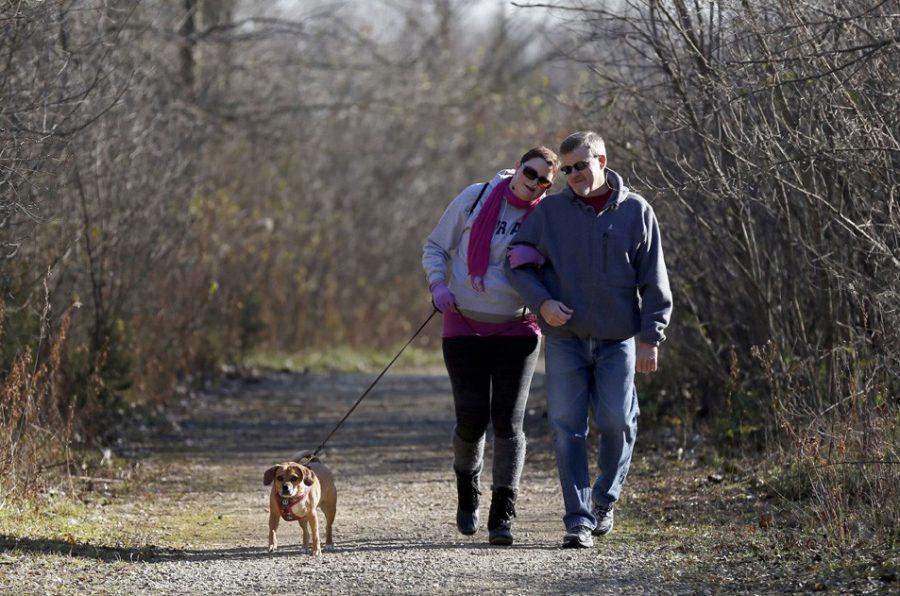CHICAGO — November was Lung Cancer Awareness Month, but you’d never know it. Consumers aren’t bombarded by products in blue, the color designated by some to raise the profile of the disease. No NFL players or coaches wore blue-ribboned apparel, despite donning pink just a month earlier for breast cancer.
“It just doesn’t seem fair,” said Meghan O’Brien, 31, a nonsmoker diagnosed with stage 4 of the disease last year. There is no stage 5.
Lung cancer is the leading cause of cancer death in the United States, claiming more lives than breast, prostate, colon and pancreatic cancers combined. The five-year survival rate is just 16 percent — a statistic that has barely budged since 1975, according to the American Cancer Society.
But lung cancer is seen as a tobacco-related illness that patients somehow bring upon themselves.
About 10 to 15 percent of the roughly 228,000 people diagnosed with the disease each year were never smokers, according to the LUNGevity Foundation, a Chicago-based support organization.
However, nowhere is the disparity felt more acutely than in funding research. The National Cancer Institute estimates that $17,835 is spent per breast cancer death versus $1,378 for lung cancer, even though lung cancer accounts for almost 23,000 deaths annually among nonsmokers.
“If we don’t start paying attention and changing attitudes, we will have a losing battle ahead of us,” said Dr. Ravi Salgia, O’Brien’s oncologist at University of Chicago Medicine.
Not that it’s easy to build awareness. Forget the pink marketing blitz; just try to find a ribbon for lung cancer. There’s even dispute over the appropriate color, according to Andrea Ferris, president and chair of the LUNGevity Foundation, who says it’s blue. Others say it’s clear or pearl.
“In every other disease, the first question people ask is, ‘How can I help?’ But with lung cancer, there’s no empathy. It’s always, ‘Did you smoke?’ After a while, it’s just easier not to say anything,” Ferris said.
In O’Brien’s case, doctors pinpointed a rare genetic mutation, called ALK, created when two normal genes fuse together to form a new, cancer-causing one.
The University of Chicago is one of the nation’s major treatment centers because of a clinical trial for crizotinib, part of a new arsenal of drugs designed to help patients by blocking ALK. This pharmaceutical “Hail Mary” helped contain O’Brien’s cancer for a while, but now it has come roaring back, invading her lungs and brain. Two months ago, a scan revealed a liver studded with tumors.
The Huntley woman is now in another early stage clinical trial and channeling her waning energy into chipping away at the “blame and shame” that has impeded progress.
“I try not to get too mad when people ask if I smoked,” she said. “Instead, I try to turn it into an opportunity to talk about it … to educate. I guess that’s the teacher in me.”
Even so, O’Brien immediately recited her virtuous health habits: Physical education teacher. Avid tennis player. An “almost vegetarian” who hasn’t rolled through a fast-food window since age 13.
No cigarettes, ever.
At first she had experienced back pain, which she attributed to muscle strain, a logical explanation for someone so active. But in May 2012 it became excruciating. She went ahead with X-rays, paying the $600 tab herself because, as a teacher’s aide at New Trier High School, she didn’t have health insurance. The results were inconclusive.
By the end of summer she had landed a full-time job teaching physical education at Kenwood Academy High School in Hyde Park, allowing her to move out of her parents’ home and into her own apartment in Bridgeport.
However, just as her “grown-up life” was taking off, it splintered apart.
On Sept. 1, the first day of her new job, she went to her neighborhood clinic. The physician took one look at her test results and sent her to University of Illinois at Chicago’s emergency room. Six hours later, a nurse told her to call her parents.
Even after being admitted to the oncology floor, cancer didn’t enter her mind.
But two weeks later, a doctor confirmed the worst: stage 4 non-small cell lung cancer, already assaulting other organs. O’Brien spent most of the next four months in the hospital. Before she could start therapy, she needed emergency spinal surgery to remove the malignant tumors wrapped tenaciously around her spinal cord. Surgeons removed several of her vertebrae, replacing them with titanium rods and screws.
The ultimate indignity, she said, “is when people ask, ‘Are you sure you never smoked?’ As if I forgot.”
Not that anyone deserves the deadly diagnosis. It wasn’t so long ago that the military dispensed cigarettes to soldiers, and many lung cancer patients kicked the smoking habit decades ago, she said. “But it doesn’t matter. … People still think it’s your fault.”









